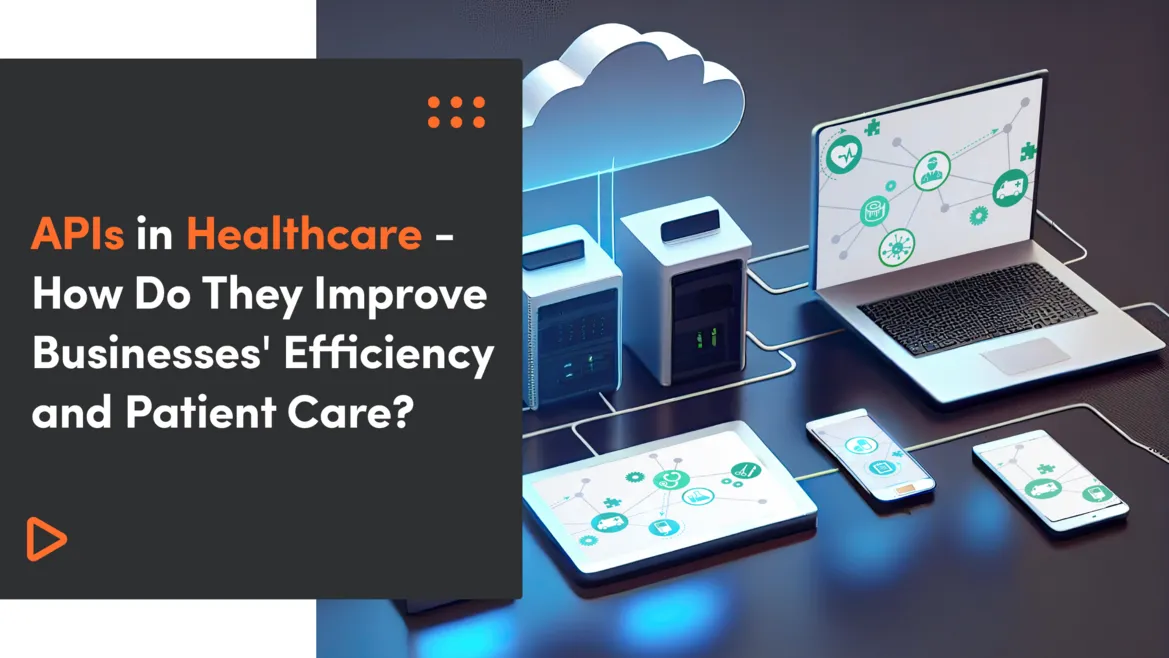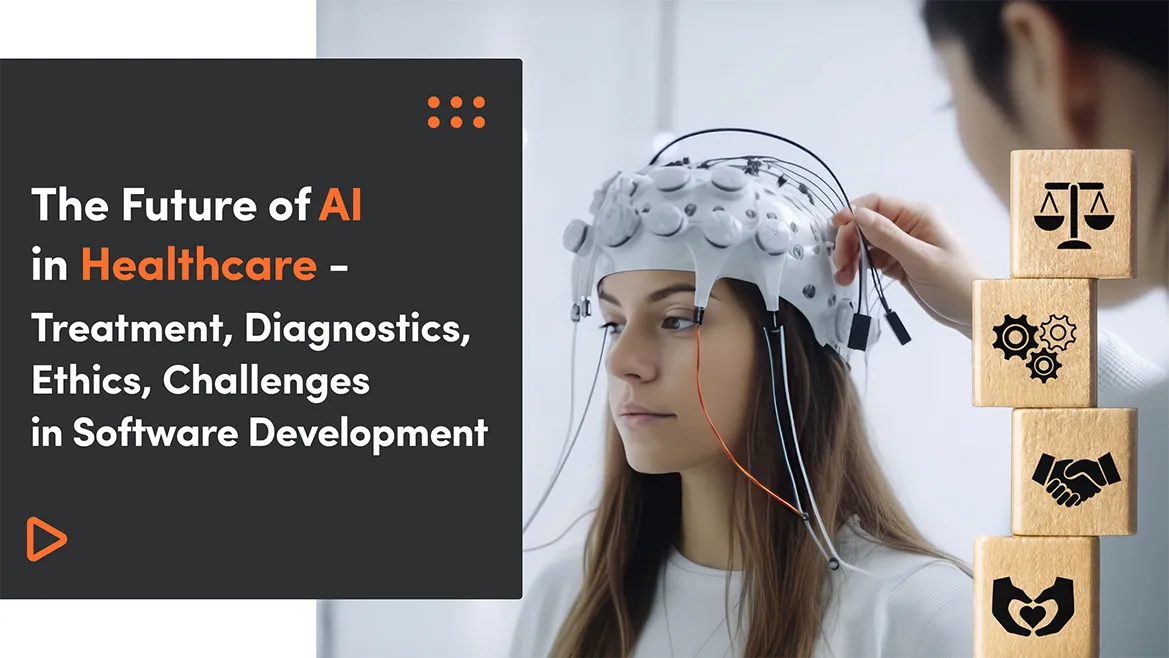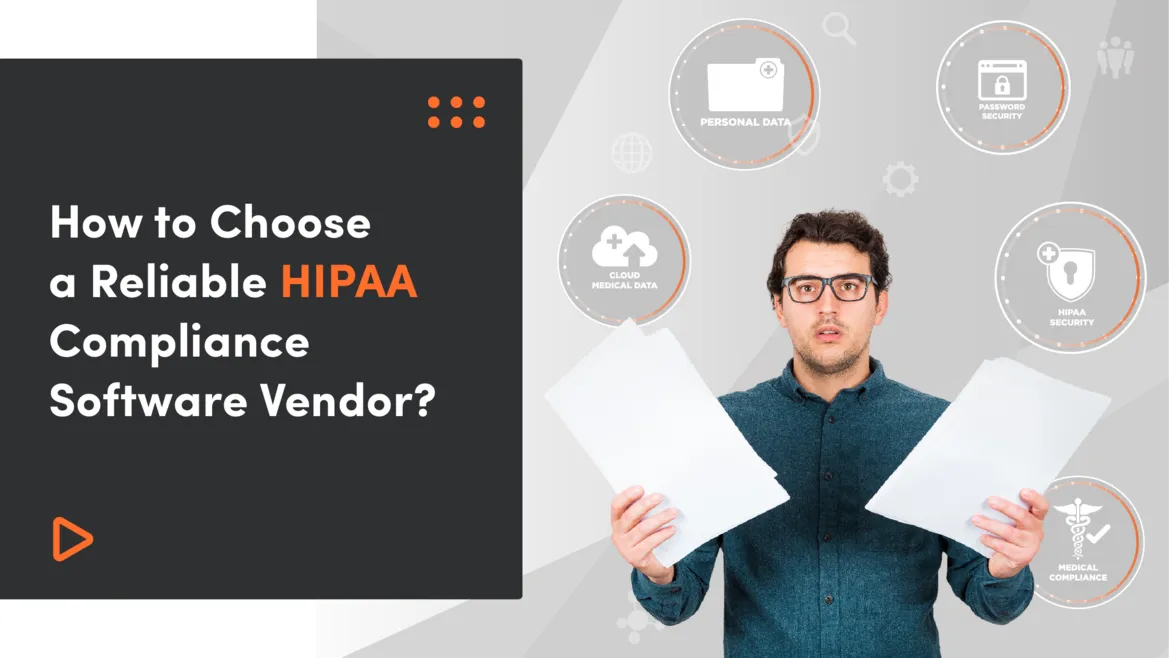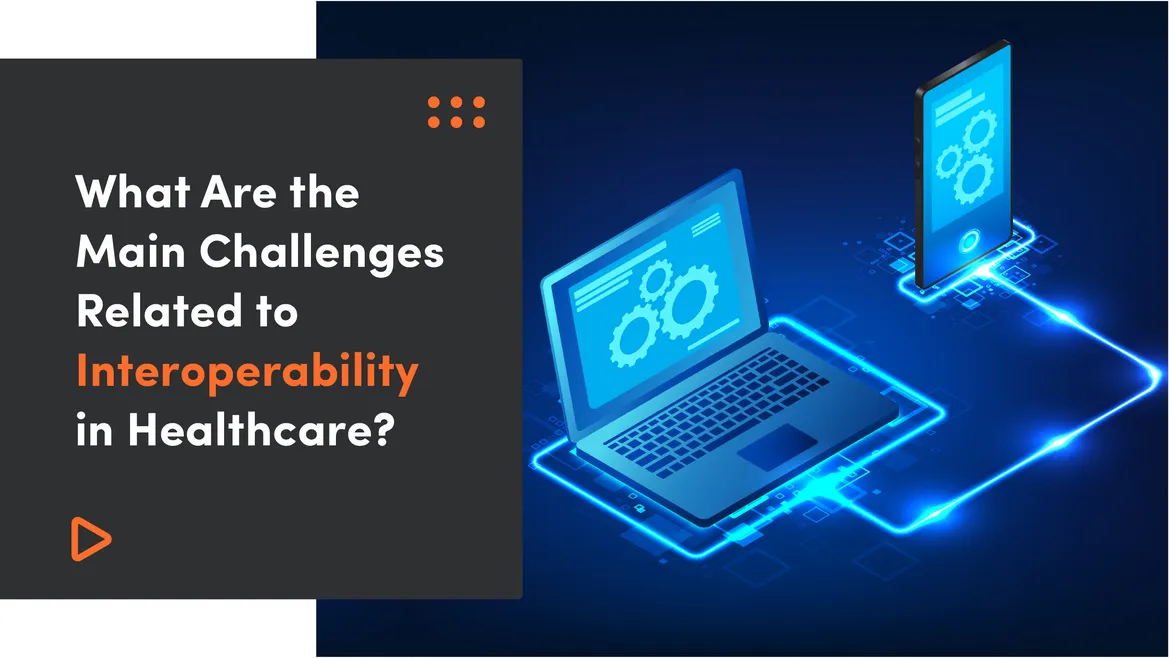Healthcare APIs allow information systems to communicate and exchange data with one another. Due to healthcare Application programming interfaces (APIs), every interested party from patient to physician to medical researcher can instantaneously access medical data sets online.
Using data from healthcare providers, payers, and digital healthcare enterprises, the study forecasts that 67% of providers and 63% of payers will utilize APIs at scale by 2023.
In 2019, 84% of hospitals and 61% of physicians used Fast Healthcare Interoperability Resources FHIR-enabled API technology in their practices to boost the performance of their businesses.
This article will look at the revolutionary impact of application programming interfaces in data interchange in healthcare, and help solve complex clinical problems. Continue reading to see how this digital intermediary improves health information technology communication across healthcare industries. We will also look at the problems of API adoption and why it might be delayed.
The article will elaborate on the following details:
- What are APIs and why are they important in the Healthcare system?
- Benefits and Challenges of APIs in Healthcare systems
- Type of healthcare APIs and the patient's encounter use cases
- Top 5 APIs to use in healthcare systems
- Future of Healthcare APIs and new trends
- What is healthcare data integration and interoperability?
What Are APIs and Why Are They Essential for Healthcare Businesses?
IBM describes the API function as: "An intermediary layer that processes data transfers between systems letting companies open their application data and functionality to internal departments within their companies, as well as external third-party developers."
As the data sharing regulations of the 21st Century Cures Act encourage standardization and proliferation throughout the healthcare ecosystem, APIs will play a significant role in health IT interoperability now and in the future.
With the use of a standardized implementation model of the application programming interface, a health system may be operating one EHR in the office, another in the hospital, and the anesthesiology department may be utilizing a third, and before the patient even leaves the OR, their essential clinical data is exchanged over an extensive number of disconnected data silos. APIs could propel the industry to unprecedented levels of consumption and interoperability by establishing a single data exchange and communication point.
The Benefits and Challenges of APIs in Healthcare
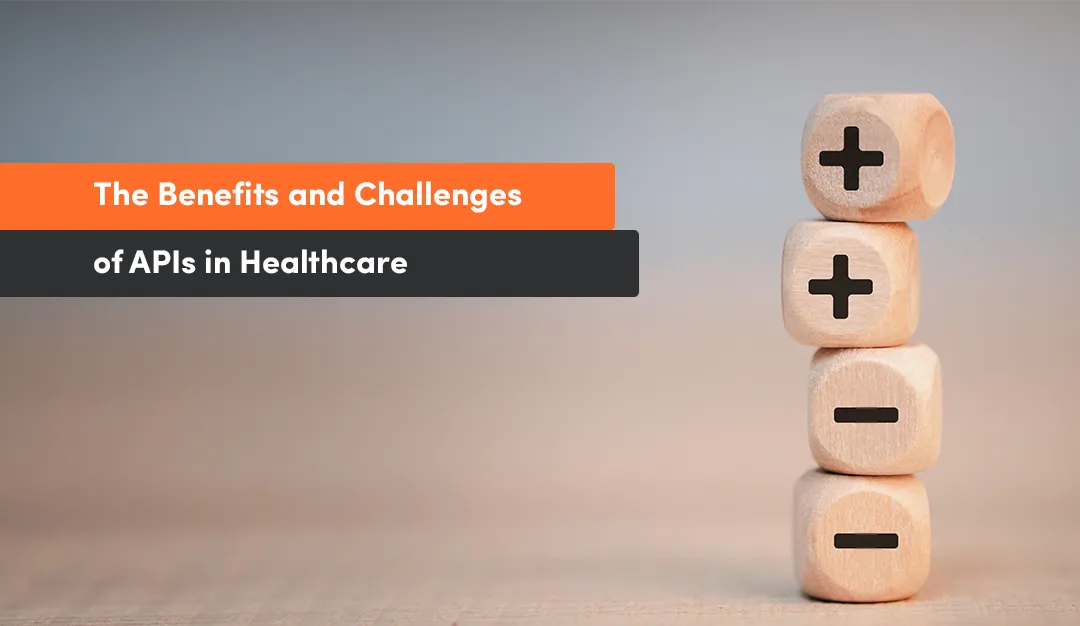
API provides several advantages to healthcare organizations, payers, and health insurance portability businesses. It also has limitations and issues when it comes to system integration. This section will educate you about the benefits and drawbacks of healthcare APIs.
Benefits of APIs in Healthcare
APIs are quite useful in any industry. However, there are some special benefits when it comes to healthcare.
- Boosting the development process: Because using APIs speeds up the development process without affecting the end-user experience, APIs contribute to rapid, creative development in the healthcare industry.
- Integration and personalization: By data exchange with a third-party app, businesses can better understand what other applications patients use to track their health, how users manage this demographic data, and what worries them about their health, allowing them to design better services based on this knowledge.
- Enhanced Patient Engagement: By offering a complete picture of a patient's medical data, the Business API enables healthcare organizations to deliver personalized and proactive treatment, resulting in higher patient engagement and satisfaction.
- Workflow Automation: It streamlines healthcare operations by automating procedures, lowering administrative responsibilities, and assuring seamless collaboration across healthcare teams.
- Scalability and adaptability: The Health Cloud Business API is extremely scalable, allowing healthcare organizations to support expansion while adapting to changing needs. Its adaptability allows for modification to meet unique business requirements.
- Capabilities for Healthcare Data Integration: API interfaces smoothly with other products and third-party systems, allowing interoperability and centralizing data exchange for quick decision-making.
- Compliance and Security: Health Cloud complies with industry standards and laws, protecting data privacy and Security, including HIPAA and GDPR compliance.
Challenges of APIs in Healthcare
Despite all the benefits, there can be some limitations to the API introduction. Here are the main ones:
- Budget: Creating a corporate healthcare solution always costs money. The establishment of the API raises the total even further.
- Security and privacy: There are more requirements for safeguarding medical information. For instance, access via APIs can be authorized and authenticated using third-party apps.
- The culture and workflow: The process of data exchange starts when the patient starts creating data and receiving access to specific data sources. Certain firms exhibit caution over the inflow of data.
- Learning Curve: Healthcare organizations may need to devote time and money to employee training to fully utilize the platform's features after adopting the Health Cloud Business API.
- Complexity of Customization: Advanced modifications may require Salesforce development and management knowledge to ensure a successful deployment.
Try our developers.
Free for 2 weeks.
No risk. Just results. Get a feel for our process, speed, and quality — work with our developers for a trial sprint and see why global companies choose Selleo.
Data Integration and Interoperability
There is a substantial difference between healthcare data Integration and Interoperability. Integration refers to the method of connecting applications to access data sources from one system. However, integration involves a third party such as "middleware" that translates the data and makes it "work" for the receiving system. Integration doesn't provide a direct path for information to get from point A to point B.
Whereas, Healthcare Interoperability cannot only share information but also interpret incoming data and present it as it was received, preserving its original context.
For instance, when a hospital's IT system and the electronic health record (EHR) of a primary care physician (PCP) are integrated, healthcare interoperability is accomplished.
There are several approaches to accommodate this data flow. These consist of:
- Interaction of clinical data via healthcare data integration services.
- A care team member using a different software system to access another directly
- Systems inform one another of certain occurrences or activities.
Fast healthcare interoperability resources, which support linking systems and exchanging information, are made possible via healthcare data integration.

The 2023 State of Interoperability is a comprehensive analysis produced in January by Health Gorilla, a software platform promoting interoperability. Its contents provide in-depth analyses from over 130 senior healthcare decision-makers, and it was determined that data sharing and quality issues still exist.
Statistics from the report further solidify the need for comprehensive integration and interoperability:
- 60% of health systems receive duplicate, incomplete, and junk data
- 69% of health organizations receive incomplete data
- 69% of digital health executives receive incomplete data
- 32% of diagnostic labs do not contribute at all to a health information exchange (HIE); when they do, 76% participate only regionally
- 40% of surveyed EHR vendors are aware of a potential need to join a Qualified Health Information Network (QHIN) but are not prioritizing this action
Integration and interoperability are not fully adopted, mainly because of concerns about patient privacy, data security, and challenges in implementing new technologies.
How Do Healthcare API Solutions Improve Patient Outcomes?
Healthcare APIs improve patient outcomes by increasing cooperation between healthcare professionals and patients, which leads to a better user experience, more care, and feasibility in accessing medical data.
Healthcare organizations produce an incredible volume of patient data daily, including test results, vital signs, medical histories, and prescription data. APIs can lessen test duplication while enhancing clinical decision-making as they make it simpler for healthcare practitioners to access and exchange patient data. Patients with complicated medical histories or chronic ailments should pay particular attention to this as they may find it difficult to track their medical information and frequently see many healthcare providers.
Patients are unwilling to participate in their care passively. APIs are essential in enabling patients to engage in more active participation. By granting patients access to medical records, they can dispel the mystery surrounding the healthcare system. Patients are more likely to be more proactive in managing their health when they are better informed about the process. Patient access to their medical data provided by healthcare organizations is an important part of data integration strategies.
Research indicates that 98% of medical providers concur that health information technology is essential to delivering an exceptional patient experience.
What Are the Types of Healthcare APIs
There are different types of APIs available for the healthcare industry. The most important Healthcare APIs are as follows:
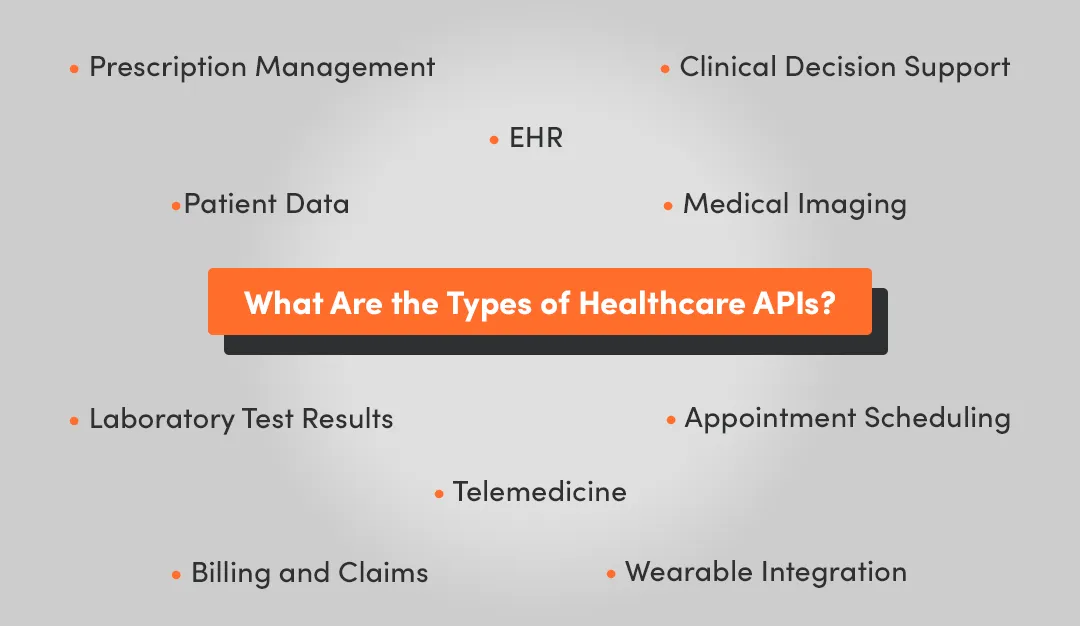
EHR
The ability to access and integrate patient data inside an Electronic Health Records (EHR) system is provided through an API for developers. Medical documents, test findings, and more patient data can be extracted for application usage.
Patient Data
EHRs, pharmacies, insurance companies, and other sources of patient data can all be accessed and integrated by developers using this API. This kind of API makes it possible to develop apps that assist patients in managing their medical plans and prescription schedules.
Clinical Decision Support
Clinical data from several sources, including laboratory systems and EHRs, can be accessed and integrated by doctors via this API. In most cases, it is utilized to give medical practitioners suggestions for diagnosis and treatment based on a patient's medical records.
Telemedicine
This one allows developers to access and integrate healthcare data from telemedicine systems. This API is suitable for apps that offer remote patient monitoring, medical counseling, and other health-related services.
Medical Imaging
Developers can employ this API to retrieve and combine medical imaging data from diverse sources. It can assist healthcare practitioners in assessing patient conditions, performing sophisticated studies, and diagnosing illnesses.
Laboratory Test Results
Developers can employ this KPI to retrieve and integrate laboratory test results from diverse sources. This API type can assist providers in analyzing patient data, monitoring health trends, and detecting possible ailments.
Prescription Management
It enables developers to obtain and combine prescription data from numerous sources. Healthcare providers utilize it to monitor patient drugs, securely handle payments, and produce prescription consumption data.
Billing and Claims
This is an API for handling billing and claims processes, such as filing claims, tracking payment status, and reconciling payments. It also automates invoicing and claim procedures, which helps to decrease expenses and enhance efficiency.
Appointment Scheduling
This is an API for scheduling appointments and handling appointment reminders. It is intended to make it easier for healthcare practitioners and patients to organize their appointment calendars.
Wearable Integration
Developers can access and integrate wearable device data using this key performance indicator. Application developers can use the wearable API to create wearable health monitoring devices, measure vital signs, and track users' activity levels.
TOP 5 APIs in Healthcare Applications in 2023
Here is a list of top five APIs in healthcare used by many known healthcare organizations in 2023.
Cerner API
Cerner APIs are healthcare software interfaces that let you connect your healthcare app to Cerner's EHR systems for accessing PHI data.
Purpose
To access patient health data and administrative information in apps.
Key Features
- Access to Patient Health Information (PHI)
- Administrative Data Integration
- Patient Interaction Features
- Clinical Decision Support Tools
- Customizable Data Management Tools
- Analytical Tools
Allscripts API
With the help of Allscripts, a healthcare API, you can link your applications to EHR systems and handle the operational and clinical requirements of the healthcare organization.
Purpose
For healthcare apps/ services to access PHI info from EHR systems
Key Features
- Administrative data integration
- Access to PHI
- Engagement tools
- User analytics
- Data management
National Drug Code (NDC) Directory API
The National Drug Code (NDC) directory API is a data service provided by the United States Food and Drug Administration (FDA) that allows you to obtain drug information.
Purpose
This healthcare API retrieves accurate and up-to-date drug information
Key Features
- Contains info above 20000+ drugs
- Drug search with NDC code
- Avails drug label information like dosage, warning, and side effects
- Regular updates
- Supports XML, JSON, and CSV
OpenFDA Drug API
The OpenFDA Drug API is software built for online platforms to access and obtain medicational drug-related information from the United States Food and Drug Administration (FDA).
Purpose
Gives public access to information on medicational drugs from the FDA
Key Features
- Allows users to filter and locate medical data such as the medicine name, National Medicine Code (NDC), manufacturer, and more.
- Includes specific details such as medicine labels, dosage, cautions, and indications.
- Reports on events and errors connected to medicine and their results.
- Third-party FDA connections, such as Food API and Device API, are supported.
Validic API
Validic API is a well-known healthcare API that enables businesses to collect patient-generated health data from various sources.
Purpose
Gives public access to information on medicational drugs from the FDA
Key Feature
Retrieves patient-generated health data from different sources into apps/ systems.
Use Cases and Case Studies of Healthcare APIs in the USA
Data integration can identify gaps and improve access for doctors, patients, and third-party service providers. Here are some of the healthcare use cases with a unified patient view:
- Prescription fulfillment API
Prescription refills and fulfillment are both possible with Walgreens APIs. For instance, customers of third-party applications can quickly purchase prescription refills that were first filled at any of the 8,200+ Walgreens pharmacies due to the prescription API. Notifications on the availability of their prescription order for pickup can also be sent to them.
- Diagnostic API
The diagnosis determines the quality of therapy, which is an important aspect of the patient's care cycle.
According to research, diagnostic errors are responsible for 80,000 deaths in the US each year.
Health units can easily collect data and comprehensive patient perspectives and tailor patient care using a contemporary healthcare data integration solution incorporating AI and ML capabilities in real-time. Practitioners can develop diagnoses based on a patient's history rather than only depending on their records.
Diagnostic APIs can be used to provide possible diagnoses based on symptoms. Apple Health Records API is one of the best examples for the given scenario.
- Healthcare data storage API
Patient data is critical as timely data transmission can significantly impact the patient's treatment. Furthermore, because patient data is very sensitive, adherence to rules and regulations is essential.
For example, AdvancedMD Patient APIs enable developers to access patient complete data securely and show it to the patient or a designated responsible person, such as a parent or guardian.
- Research API
Health care research API provides access to research information and data silos on different fields such as:
Protein sequencing, neuroscience, or toxicology.
For example, Google Cloud Healthcare is best suited for telehealth apps that use health analytics software for clinical research.
- Health information API
These APIs provide access to general and specific health information on different topics, such as:
- Symptoms information
- Lifestyle tips
- Medicine information, such as side effects and how to take them
- Review of healthcare organizations
Bluestream Healthcare provides many APIs that allow developers to get access to healthcare-related information.
The Future of API Interoperability in Healthcare
The 21st Century Cures Act data exchange rules, which promote standardization and growth among healthcare interoperability businesses, indicate that healthcare APIs have a promising future. Anticipate an increase in the use of APIs in the healthcare industry in the next few years to link providers to more comprehensive data, enhance patient outcomes, and provide the general public with better access to their medical information.
The healthcare business cannot optimize interoperability unless it adheres to data standards. Standardized data results in a linked data collection that is simple to process and utilize. This data should give the sector new levels of insight and opportunity into the requirements of patients, providers, and payers, allowing it to make better-educated decisions. API data in healthcare can then guide the industry in standardizing new data points and influencing regulations that govern and control the healthcare business.
Business cases are driving the future of APIs in healthcare for next-generation data interchange. While FHIR is intended to strive towards a completely backward-compatible standard, the industry is pressuring healthcare interoperability organizations to adopt a standardized implementation strategy.
What Is A Better Choice? Ready-Made Solution Or Custom Integration?

The main goal of healthcare API is to transmit and connect data at a single point.
Healthcare organizations have two options: choose a ready-made solution or develop a customized one with the help of an experienced healthcare software developer. Both choices have advantages and disadvantages.
A ready-made solution is cost-effective and takes less time than custom software development. They come with comprehensive features tested and refined by the software provider. Ready-made software is typically sold on a subscription or licensing basis, which helps businesses avoid upfront development costs associated with custom solutions. BUT!
In healthcare, client data safety and privacy are the biggest priorities. Any negligence can have a massive financial impact on the organization and the patient and damage the reputation. For this sole purpose and to comply with healthcare regulations, a business should consider building a custom API rather than using a third-party ready-made API.
Custom APIs provide businesses with opportunities for innovation and scalability. It also helps them cater to the changing needs of patients without halting the system. In ready-made API, a company has limited access to make the changes.
Custom API is a better option because companies can make alterations to integrate with any system or cloud computing, whereas it can not be done in ready-made API.
Summary
A new generation of creative direct-to-consumer companies is revolutionizing the healthcare and population health technology industries due to the increased desire for long-term, preventative treatment outside hospitals.
The developments in the finance and consumer tech sectors serve as inspiration for a large number of developers nowadays. A new wave of healthcare IT businesses is emerging, driven by APIs and eager to innovate in response to the growing need for patient-centered virtual care.
Healthcare APIs are the next big thing in the software development industry.
